
When recovering from a heart attack, it is recommended to do low-impact exercises, but do consult your doctor before starting any exercise to ensure that it is right for you.
What happens after a heart attack?
After a heart attack (myocardial infarction), the heart takes about four to six weeks to repair itself with scar tissue.
Returning to activities after a heart attack can be challenging and cause anxiety.
This article provides some guidelines to assist you to return to daily activities and reduce the risk of another heart attack.
Do's and Don'ts for recovery
Here are some guidelines to help in your recovery.
Below are some activities that you can perform and some activities you should avoid.
 |
 |
 |
| Stretching exercises | Standing up from and sitting down on the floor |
Cycling, swimming, golfing |
| Showering | Fishing | Gardening (General) |
| Hair styling, shaving | Sweeping, mopping | Dancing (social) |
| Washing dishes | Ironing | Cleaning, vigorous effort |
| Cooking | Walking downstairs | Climbing stairs without carrying anything |
| Typing and desk work | Carrying objects < 10kg | Carrying objects > 10kg |

Don’ts
- Do not carry more than 10 kg.
- Do not climb multiple flights of stairs at one go.
- Do not carry a load when going upstairs.
- Do not strain and hold your breath.
- Do not hold arms above shoulder level for a long time.

Important activities to note
a) Driving
Do not drive for the first month.
When you start driving again, avoid stressful situations such as driving at night, peak hours, bad weather, or high speeds.
b) Travelling by plane
Do not travel by air for several weeks after a heart attack.
Travel with a companion, carry GTN (nitroglycerine) with you and avoid rushing by requesting for airport transportation.
c) Engaging in sexual intercourse
You may have sexual intercourse with your partner if you can climb two flights of stairs easily without any symptoms (e.g. breathlessness).
d) Returning to work
Your doctor will certify when you are fit to return to work.
How to cope with stress and negative emotions
1. Have a talk with family, friends, or other trusted advisors about your concerns and ask them for their support.
2. Take 15 to 20 minutes a day to sit quietly, breathe deeply and think of a peaceful scene.

3. Learn to accept things you can’t change. You don’t have to solve every problem.
4. Count to 10 before answering or responding when you feel angry.
5. Do not use smoking, drinking, overeating, drugs or caffeine to cope with stress as these will only make things worse.
6. Look for the good in situations instead of the bad.
7. Exercise regularly. Do something you enjoy, like walking, swimming, jogging, golfing, walking a pet, tai chi or cycling. Check with your doctor to determine what activity level is right for you.

8. Think ahead of what may upset you and try to avoid it. For example, spend less time with people who bother you. If you’re still working, cut back on your hours and adjust your schedule to avoid driving in rush-hour traffic.
9. Learn to say no. Don’t promise too much. Give yourself enough time to get things done.
10. Join a support group. For example, people with heart disease, for women, men, retired persons or some other group you identify with.
11. Inform your doctor if you can’t cope on your own.

What is a heart attack?
A heart attack (also known as myocardial infarction) occurs when there is a sudden, complete obstruction of blood flow in the coronary artery.
The part of the heart muscle which does not receive blood would be at risk of injury or damage.
Eventually, scar tissue will replace parts of the heart muscle which have died due to the lack of blood flow.
A heart attack is a serious condition which requires emergency treatment. It usually involves blood-thinning medication and coronary angioplasty to quickly remove the blockage in the affected coronary artery, allowing blood to flow.
In some cases, coronary artery bypass surgery (CABG), an open heart surgery, may be required.
Ref: G25 (ed)
Related article:
Heart Surgery: What to Do for Quicker Recovery
Contributed by


















 Get it on Google Play
Get it on Google Play